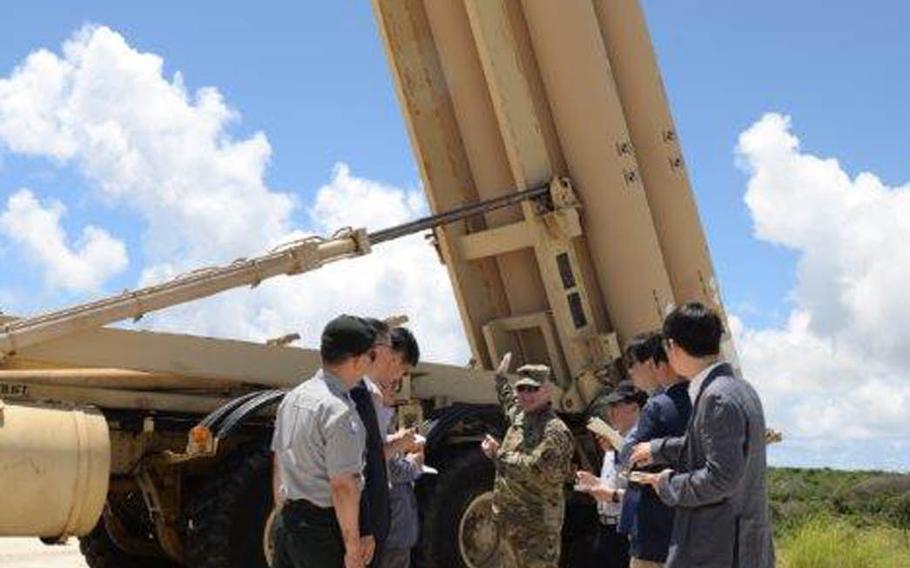
South Korean media and Stars and Stripes were given a tour of the Terminal High-Altitude Area Defense system site at Andersen Air Force Base, Guam, Tuesday, July 19, 2016. The tour included senior U.S. and South Korean defense officials as well as soldiers with Task Force Talon, THAAD's operator on the island. (Joshua Smoot/U.S. Air Force)
ANDERSEN AIR FORCE BASE, Guam — The U.S. military offered a rare glimpse of an advanced missile defense battery in a bid to help the South Korean government convince its populace that the system is safe and vital to security on the peninsula.
Washington and Seoul agreed to deploy a Terminal High-Altitude Area Defense system, known as THAAD, in a mountainous region southeast of Seoul to counter a growing missile threat from North Korea.
But critics, especially residents of Seongju county where the system will be based, fear the unit’s powerful radar will harm health, the environment and the economy.
Unable to assuage the concerns, South Korean and U.S. officials decided to try putting a friendly face on the system.
At the request of the government in Seoul, the U.S. military took a small group of Korea-based reporters, including one from Stars and Stripes, on a tour Monday of the only forward-deployed THAAD system, set up on the U.S. territory of Guam just over two years ago.
“North Korea poses a threat to South Korea, as they do to us here in Guam,” Rear Adm. Bette Bolivar, commander of Joint Region Marianas, said in a briefing. “THAAD is one of those tools that continues to keep us safe.”
Equipment — including the X-band radar and two truck-mounted launchers loaded with eight interceptors each — was sprawled across a rocky, shrub-covered clearing known as Site Armadillo in a remote corner of Andersen Air Force Base.
Generators, which are the site’s sole source of power, roared in the background. Officials said South Korea’s THAAD will use conventional power to mitigate the noise factor.
A dirt berm marks the no-man’s land extending about 330 feet in front of the radar. A blinking red light warns people when it is radiating.
The military turned it off for the tour, which included senior U.S. and South Korean defense officials as well as soldiers with Task Force Talon, THAAD’s operator in Guam.
Officials acknowledged the island’s flat terrain is starkly different from the mountainous Seongju region but said that provides only more reassurance.
The radar has to be tilted upward at an angle of at least 5 degrees to detect incoming missiles, although officials, citing operational security, declined to offer specific angles for the sites. That means the risk of exposure to people on the ground is negligible as long as they are at least 330 feet away from the front of it, the military said.
“This risk is further mitigated by placing the radar at higher elevations relative to the surrounding area, as is planned in Seongju,” according to a fact sheet.
The military also said all THAAD deployment sites conformed to the most conservative standards for radar emission exposure and were verified by the U.S. Missile Defense Agency.
“This visit should reinforce that an operational THAAD battery does not pose health, environmental or safety risks to our soldiers, servicemembers, their families or the public,” said Maj. Gen. Robert Hedelund, commander of U.S. Marine Corps Forces Korea and a leader of the joint working group on THAAD.
“Just as importantly, it provides a critical capability for a layered ballistic missile defense network designed to defend [South Korea] against North Korea’s evolving ballistic missile threat,” he said.
THAAD interceptors don’t carry a warhead but are designed to shoot down short-, medium- and intermediate-range ballistic missiles by smashing into them during their “terminal” phase, when they re-enter the lower atmosphere after traveling in space.
South Korean officials have said they hope to have the system operational by the end of next year and expressed confidence it will protect up to two-thirds of the country’s population along with critical infrastructure.
Military officials say the system will contribute a higher-tier layer of protection to complement existing Patriot and Aegis defense systems designed to intercept missiles at a lower level.
Camp Humphreys, the Army garrison that will be home to the new U.S. Forces Korea headquarters in coming years, as well as key air and naval bases are in the protection range.
Defense experts agreed the system does not likely pose a health problem but expressed concerns about other factors, including whether the site will be targeted by the North and whether Pyongyang could overwhelm the system with its massive arsenal and decoys.
THAAD has been successful in operational and developmental tests, officials said, but has never faced combat, where conditions can be unpredictable.
“How are these systems going to perform? Unfortunately, we won’t know an answer until we have a war,” said Michael Elleman, a senior consulting fellow at the International Institute for Strategic Studies, a global think tank.
He said THAAD would enhance South Korea’s ability to defend itself against North Korean missiles, but its effectiveness against a nuclear attack would likely be limited.
“You’re not creating an umbrella,” Elleman said in a telephone interview. “You’re creating a defense that will probably be pretty effective, but it’s not leakproof.”
gamel.kim@stripes.comTwitter: @kimgamel